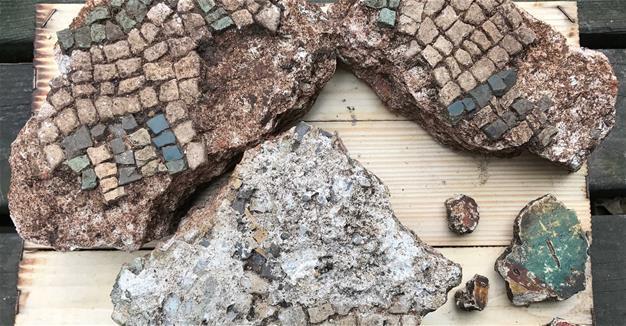Daily life examined in Byzantine religious center in Turkey's Giresun
GİRESUN

Ancient life and traditions on the Giresun Island are being examined in archaeological excavations carried out in a monastery complex on the Black Sea island, reputed as a significant religious center in the Byzantine era.
The Giresun Island is famous for myths like the Argonauts (a band of Greek heroes), including Hercules, who came to the island to find the Golden Fleece under the leadership of Jason. Excavations there were initiated in 2011 and have been continuing since then.
In the first week of the works that have been continuing in the fields of the biggest structures of the island, a church, tower and monastery, ruins of some structures and six tombs, buried with Byzantine burial traditions, were unearthed.
Speaking to state-run Anadolu Agency, academic consultant for the excavations and a member of Celal Bayar University’s history of arts department, Gazanfer İltar, said they found several artifacts even though they just started digging the field.
He said among the most important findings of this year are the pieces of frescoes in yellow, red and green colors, which are supposed to be pieces of the church.
“We have never found pieces of frescoes in previous excavations. We also found mosaic pieces that we think belong to a palace under the church. Also, we found traces of foundations of some structures,” he said.
Field damaged by illegal diggings İltar said the excavation field has many tombs but most of them were destroyed because of their proximity to the surface.
“Because of illegal excavations on the island, the field was unfortunately destroyed. Especially the mosaics of the palace under the church are torn to pieces. The first anthropological examinations in the tombs showed that the skeletons here belong to men who died in their 30s,” said İltar.
He said the tombs that were covered with roof tiles were done with Byzantine burial traditions.
“A coin was put on the toe in some tombs and several scallops were left in the tomb. The excavations are very important because they shed light on the history of the island since the 3rd century B.C.”
He said the island was surrounded with walls in the past, adding that almost all of the walls collapsed throughout history and the ruins of the church, tower, monastery, chapel, cistern and lots of large storage containers, called pithos, have remained.
“The ruins of the narthex of the church will be completely unearthed. It is very important to reveal the lifestyle practiced in the island,” he added.
Ceramics from Zeuksippos family groupİltar said that for the first time this year, they unearthed many frescoes pieces.
“Another important finding is the mosaic pieces. We think that they are from the palace, which was in its place before the church. A green-glazed bowl from the historical Zeuksippos family group is the most important finding among them all. The bowl from the first half of the 13th century is the only example that was unearthed in the most east of the Black Sea region and it can be completed. Works to make the imitation of this bowl are ongoing,” he added.
İltar said most of the findings are from the 13th century and works can be finished in five seasons with a large group of people.
“The works should be finished and the restitution and restoration projects for the island should start as soon as possible. Otherwise, it will disappear,” he added.
 Ancient life and traditions on the Giresun Island are being examined in archaeological excavations carried out in a monastery complex on the Black Sea island, reputed as a significant religious center in the Byzantine era.
Ancient life and traditions on the Giresun Island are being examined in archaeological excavations carried out in a monastery complex on the Black Sea island, reputed as a significant religious center in the Byzantine era.